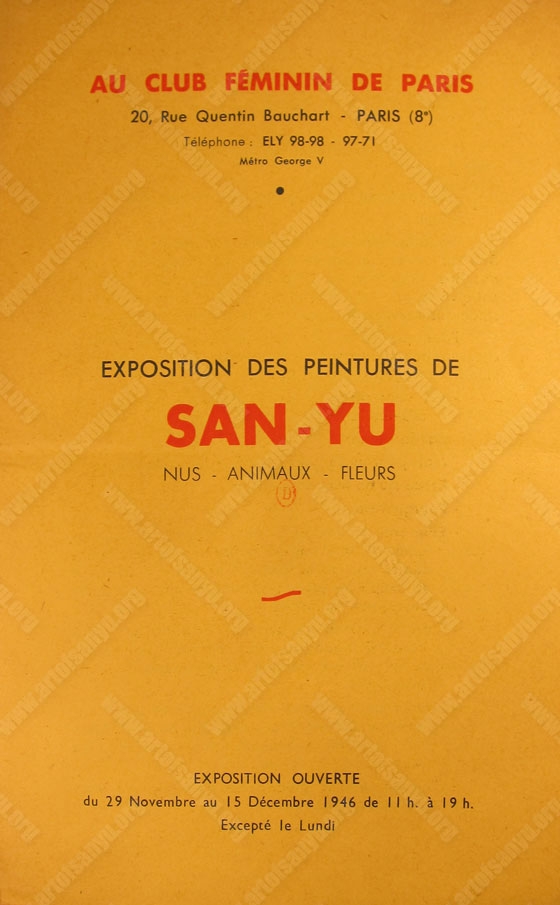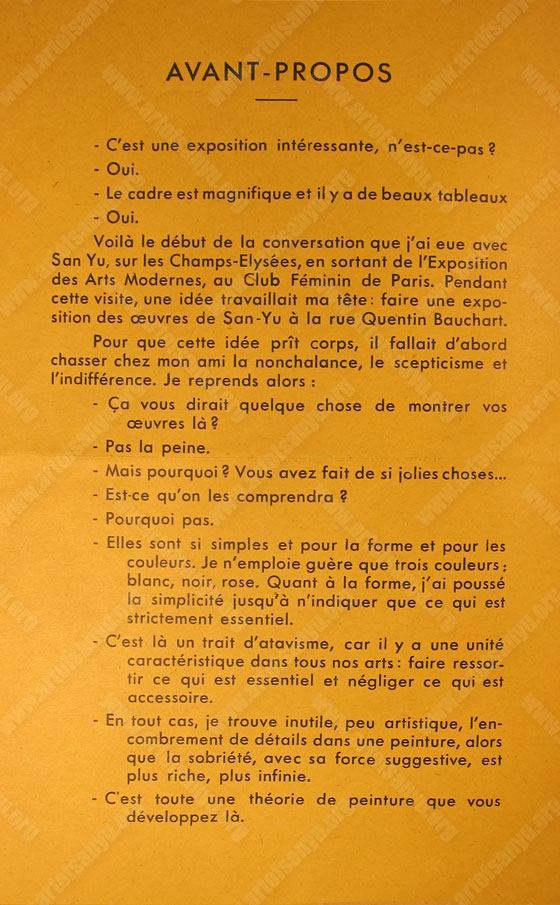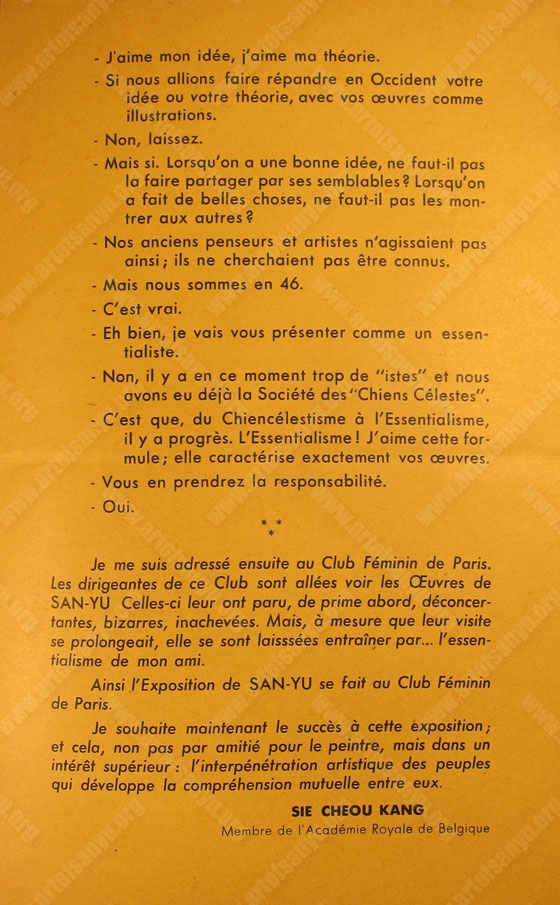– C’est une exposition intéressante, n’est-ce-
– Oui.
– Le cadre est magnifique et il y a de beaux tableaux.
– Oui.
Voilà le début de la conversation que j’ai eue avec San-Yu, sur les Champs-Elysées, en sortant de l’Exposition des Arts Modernes, au Club Féminin de Paris. Pendant cette visite, une idée travaillait ma
Pour que cette idée prît corps, il faillait d’abord chasser chez mon ami la nonchalance, le scepticisme et l’indifférence. Je reprends
– Ça vous dirait quelque chose de montrer vos œuvres
– Pas la peine.
– Mais
– Est-ce qu’on les
– Pourquoi pas.
– Elles sont si simples et pour la forme et pour les couleurs. Je n’emploie guère que trois
– C’est là un trait d’atavisme, car il y a une unité caractéristique dans tous nos
– En tout cas, je trouve inutile, peu artistique, l’encombrement de détails dans un peinture, alors que la sobriété, avec sa force suggestive, est plus riche, plus infinie.
– C’est toute une théorie de peinture que vous développez là.
– J’aime mon idée, j’aime ma théorie.
– Si nous allions faire répandre en Occident votre idée ou votre théorie, avec vos œuvres comme illustrations.
– Non, laissez.
– Mais si. Lorsqu’on a une bonne idée, ne faut-il pas la faire partager par ses
– Nos anciens penseurs et artistes n’agissaient pas
– Mais nous sommes en 46.
– C’est vrai.
– Eh bien, je vais vous présenter comme un essentialiste.
– Non, il y a en ce moment trop de “istes” et nous avons eu déjà la Société des “Chiens Célestes”.
– C’est que, du Chiencélestisme à l’Essentialisme, ily a progrès. L’Essentialisme! J’aime cette
– Vous en prendrez la responsibilité.
– Oui.
Je me suis adressé ensuite au Club Féminin de Paris. Les dirigeantes de ce Club sont allées voir les Œuvres de SAN-YU. Celles-ci leur ont paru, de prime abord, déconcertantes, bizarres, inachevées. Mais, à mesure que leur visite se prolongeait, elle se sont laissées entraÎner par . . . l’essentialisme de mon ami.
Ainsi l’Exposition de SAN-YU se fait au Club Féminin de Paris.
Je souhaite maintenant le succès à cette
SIE CHEOU KANG
Membre de l’Académie Royale de Belgique
[Translation]
“It is an interesting exhibition don’t you think?”
“Yes.”
“It is in a magnificent setting and there are beautiful paintings.”
“Yes.”
Above is the beginning of a conversation that I had with Sanyu on the Champs-Elysées, having just left the Paris Women’s Club exhibition of modern art. While visiting this exhibition, I had a recurring idea: stage an exhibition of Sanyu’s works at rue Quentin Bouchart.
To develop this idea, it was necessary to first get rid of my friend’s nonchalance, skepticism and indifference. I resumed our conversation:
“Would you like to exhibit your works there?”
“Not worth it.”
“Why? You have created such lovely works...”
“Will people understand them?”
“Why would they not?”
“They are so simple, both in form and in color. I use essentially only three colors, white, black and pink. As for the form, I have concentrated on simplicity and stripped it to the essential.”
“It is there (where we find) a trace of atavism: a unifying characteristic in all (our) art of concentrating upon the essential and ignoring that which is non-essential.”
“In any event, I find that too much detail in a painting is useless and not artistic. The suggestive force of sobriety is richer and more infinite.”
“You are developing a whole theory of painting here.”
“I like my idea. I like my theory.”
“How about using your works as examples and propagate your theory and idea in the West?”
“No. Do not go there.”
“No, when we have a good idea, should we not share this with our fellow humans? When we create beautiful things should we not show them to others?”
“Our ancient philosophers and artists did not act in this way; they did not seek fame.”
“But it is now 1946.”
“That is true.”
“So I am going to introduce you as an Essentialist.”
“There are too many ‘ists’ around now. We already have created the ‘Heavenly Dog Society (Club)’.”
“It is just that there is a progression from Heavenly Dog-ism to Essentialism. Essentialism! I like to use that word as it describes your works exactly.”
“You will take responsibility for this (decision).”
“Yes (of course).”
I then contacted the Paris Women’s Club and its Board went to view his works. Their first impression was that the works were disconcerting, bizarre and incomplete. However, the longer they stayed, the more they allowed themselves to be caught up in the Essentialism of my friend.
This is how Sanyu’s exhibition at the Paris Women’s Club came about.
I am hoping for a successful Sanyu exhibition; not through my friendship with the artist, but for the greater motive of an artistic exchange between nations that will foster mutual understanding.
SIE CHEOU KANG
Member of the Royal Academy of Belgium


